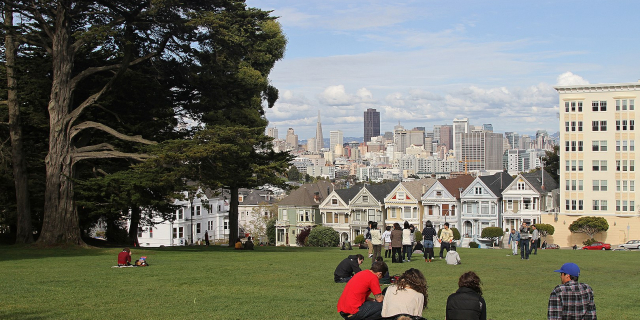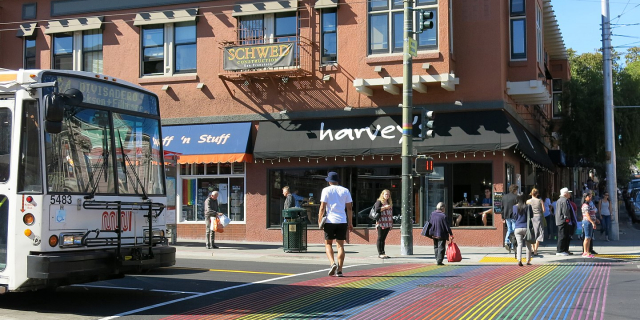Coit Tower (also known as the Coit Memorial Tower) is a 210-foot (64 m) tower in the Telegraph Hill neighborhood of San Francisco, California, overlooking the city and San Francisco Bay. The tower, in the city's Pioneer Park, was built between 1932 and 1933 using Lillie Hitchcock Coit's bequest to beautify the city of San Francisco. It was added to the National Register of Historic Places on January 29, 2008.
The Art Deco tower, built of unpainted reinforced concrete, was designed by architects Arthur Brown Jr. and Henry Temple Howard. The interior features fresco murals in the American Social Realism style, painted by 25 different onsite artists and their numerous assistants, plus two additional paintings installed after creation offsite.
The structure was dedicated to the volunteer firemen who had died in San Francisco's five major fires. A concrete relief of a phoenix by sculptor Robert Boardman Howard is placed above the main entrance. It was commissio...Read more
Coit Tower (also known as the Coit Memorial Tower) is a 210-foot (64 m) tower in the Telegraph Hill neighborhood of San Francisco, California, overlooking the city and San Francisco Bay. The tower, in the city's Pioneer Park, was built between 1932 and 1933 using Lillie Hitchcock Coit's bequest to beautify the city of San Francisco. It was added to the National Register of Historic Places on January 29, 2008.
The Art Deco tower, built of unpainted reinforced concrete, was designed by architects Arthur Brown Jr. and Henry Temple Howard. The interior features fresco murals in the American Social Realism style, painted by 25 different onsite artists and their numerous assistants, plus two additional paintings installed after creation offsite.
The structure was dedicated to the volunteer firemen who had died in San Francisco's five major fires. A concrete relief of a phoenix by sculptor Robert Boardman Howard is placed above the main entrance. It was commissioned by the architect and cast as part of the building.
Although an apocryphal story claims that the tower was designed to resemble a fire hose nozzle due to Coit's affinity with the San Francisco firefighters of the day, the resemblance is coincidental.
 Coit Tower in 2008, looking WSW
Coit Tower in 2008, looking WSWTelegraph Hill, the tower's location, has been described as "the most optimal 360 degree viewing point to the San Francisco Bay and five surrounding counties."[1] In 1849, it became the site of a two-story observation deck, from which information about incoming ships was broadcast to city residents using an optical semaphore system, replaced in 1853 by an electrical telegraph that was destroyed by a storm in 1870.[1]
Coit Tower was paid for with money left by Lillie Hitchcock Coit (1843–1929), a wealthy socialite who loved to chase fires in the early days of the city's history. Before December 1866, there was no city fire department, and fires in the city, which broke out regularly in the wooden buildings, were extinguished by several volunteer fire companies. Coit was one of the more eccentric characters in the history of North Beach and Telegraph Hill, smoking cigars and wearing trousers long before it was socially acceptable for women to do so. She was an avid gambler and often dressed like a man in order to gamble in the males-only establishments that dotted North Beach.[2]
 Robert Boardman Howard's cast concrete relief of a phoenix is placed above the main entrance to Coit Tower, a memorial dedicated to the volunteer firefighters who died in San Francisco's five major fires.
Robert Boardman Howard's cast concrete relief of a phoenix is placed above the main entrance to Coit Tower, a memorial dedicated to the volunteer firefighters who died in San Francisco's five major fires.Coit's fortune funded the monument four years following her death in 1929. She had a special relationship with the city's firefighters. At the age of fifteen she witnessed the Knickerbocker Engine Co. No. 5 in response to a fire call up on Telegraph Hill when they were shorthanded; she threw her school books to the ground and pitched in to help, calling out to other bystanders to help get the engine up the hill to the fire, to get the first water onto the blaze. After that Coit became the Engine Co. mascot and could barely be constrained by her parents from jumping into action at the sound of every fire bell. She frequently rode with the Knickerbocker Engine Co. 5, especially in street parades and celebrations in which the Engine Co. participated. Through her youth and adulthood Coit was recognized as an honorary firefighter.
In her will she specified that one third of her fortune, amounting to $118,000,[1] "be expended in an appropriate manner for the purpose of adding to the beauty of the city which I have always loved."[3] Two memorials were built in her name. One was Coit Tower, and the other was a sculpture depicting three firemen, one of them carrying a woman in his arms.[4]
The San Francisco County Board of Supervisors proposed that Coit's bequest be used for a road at Lake Merced. This proposal brought disapproval from the estate's executors, who expressed a desire that the county find "ways and means of expending this money on a memorial that in itself would be an entity and not a unit of public development".[1] Art Commission president Herbert Fleishhacker suggested a memorial on Telegraph Hill, which was approved by the estate executors. An additional $7,000 in city funds was appropriated, and a design competition was initiated. The winner was architect Arthur Brown, Jr, whose design was completed and dedicated on October 8, 1933.[1]
The following month Honore Bowlby-Gledhill, proprietor of the Dead Fish Cafe (an 'artists' restaurant') in Telegraph Hill, was charged (under the name 'Helen Smith') with shooting a pistol at the tower. Bowlby-Gledhill was quoted as objecting to the tower because it 'looked like a silo'.[5]
Coit Tower was listed as a San Francisco Designated Landmark in 1984[6] and on the National Register of Historic Places in 2008.[7] Although Coit Tower itself is not technically a California Historical Landmark, the state historical plaque for Telegraph Hill is located in the tower's lobby, marking the site of the original signal station.[8]
The San Francisco Arts Commission ordered the removal of the Statue of Christopher Columbus that had stood outside the entrance of the tower since 1957, following numerous other removals of controversial statues during the George Floyd protests that began in May 2020, and it was removed on June 18, 2020.[9]




































Add new comment